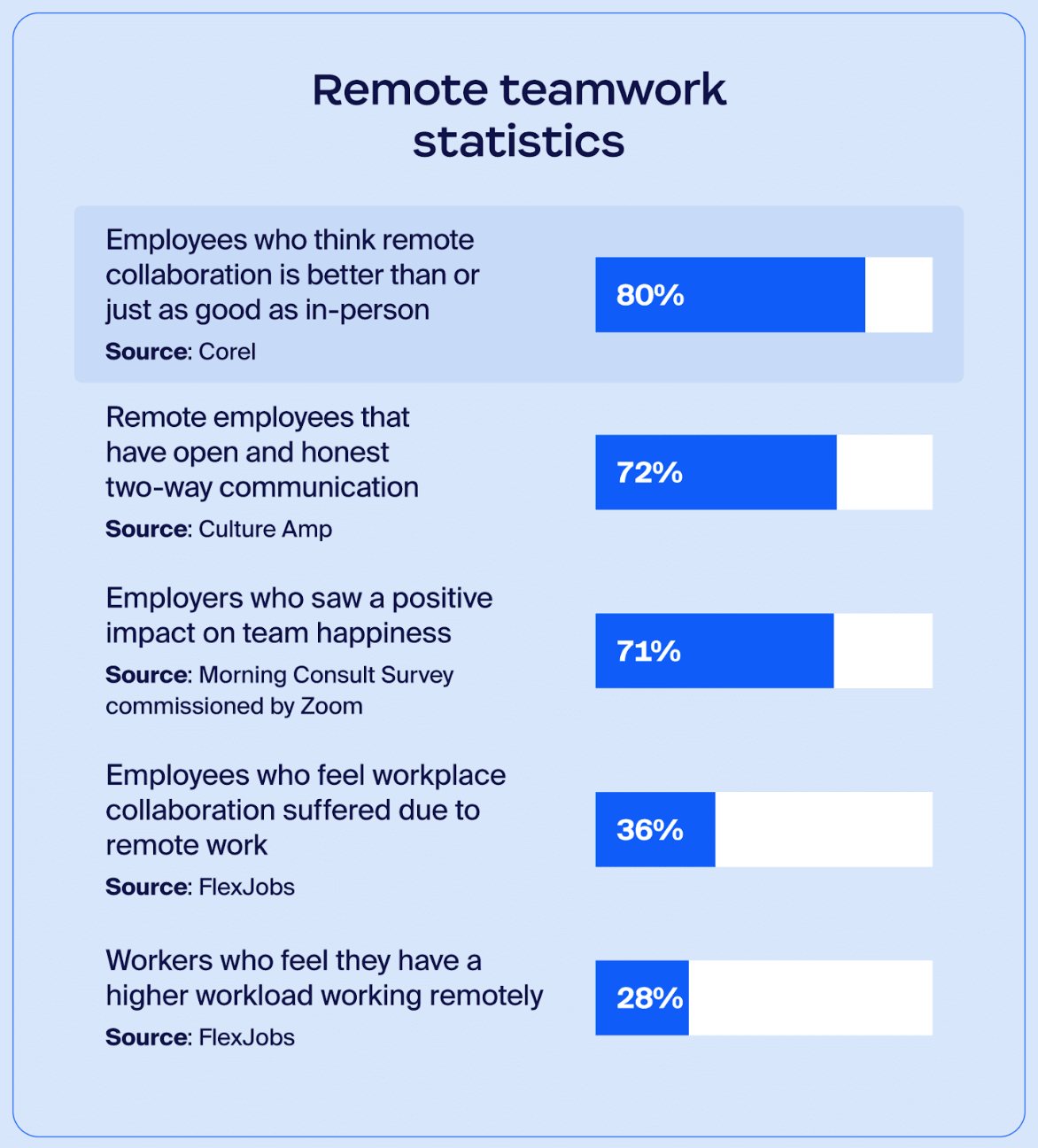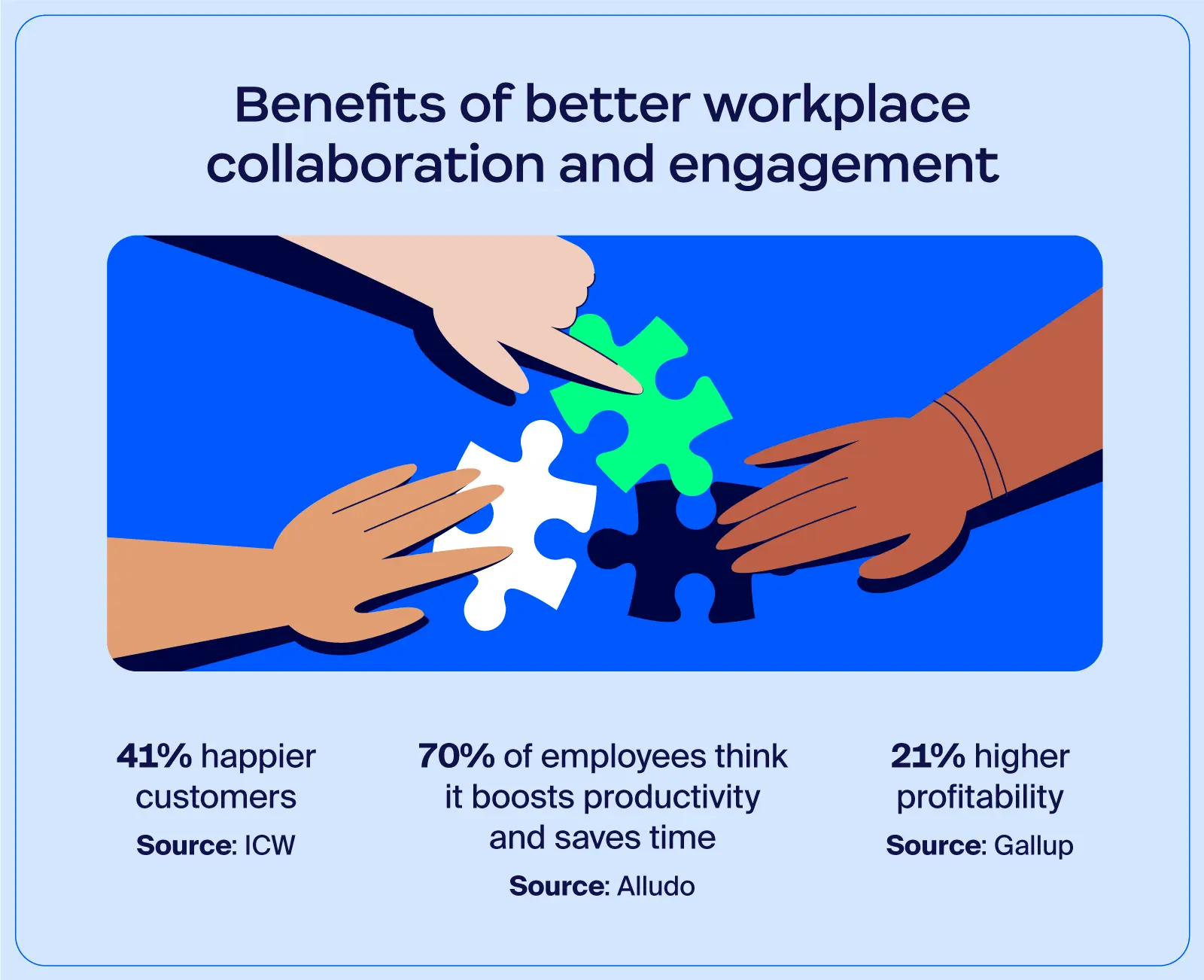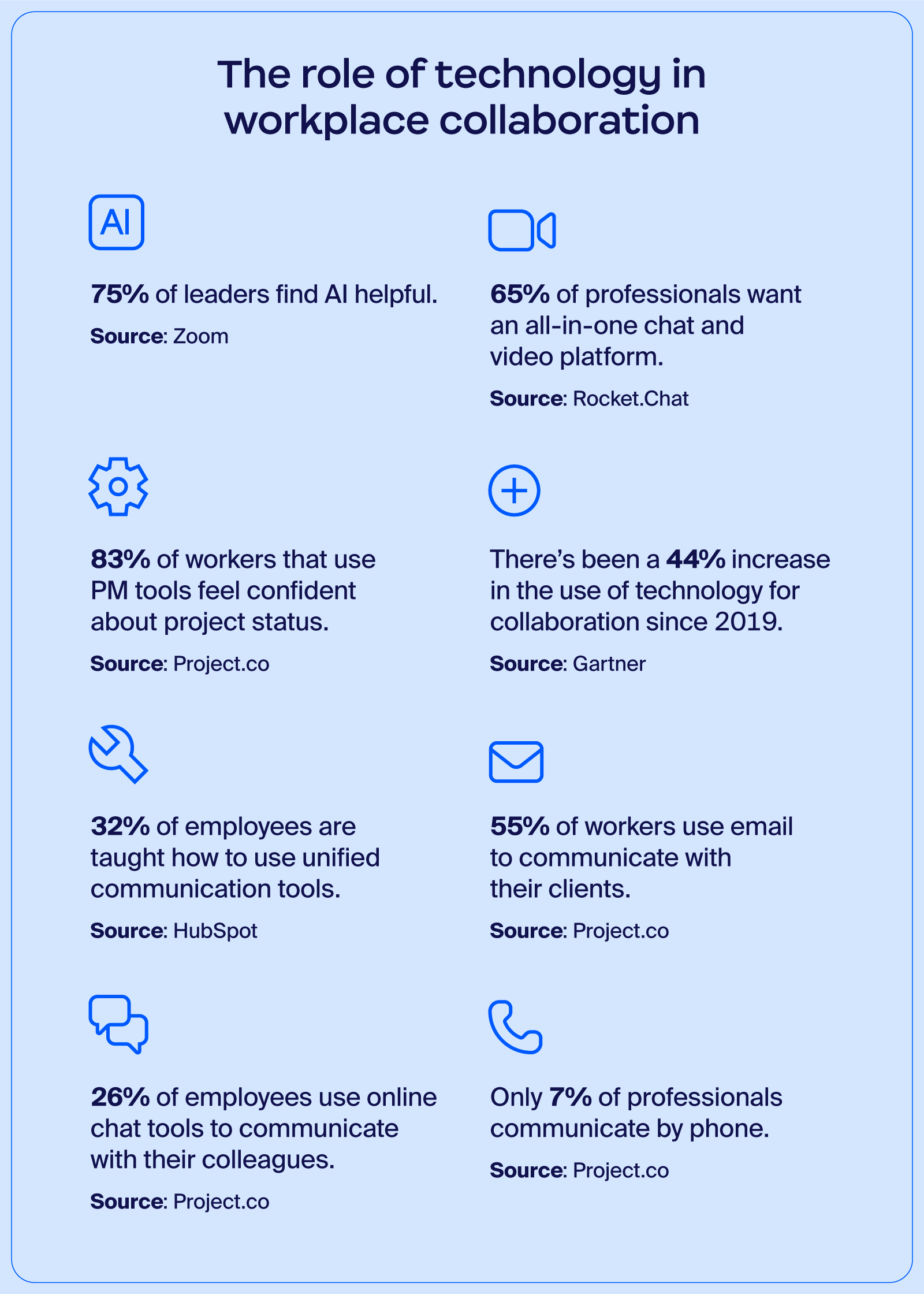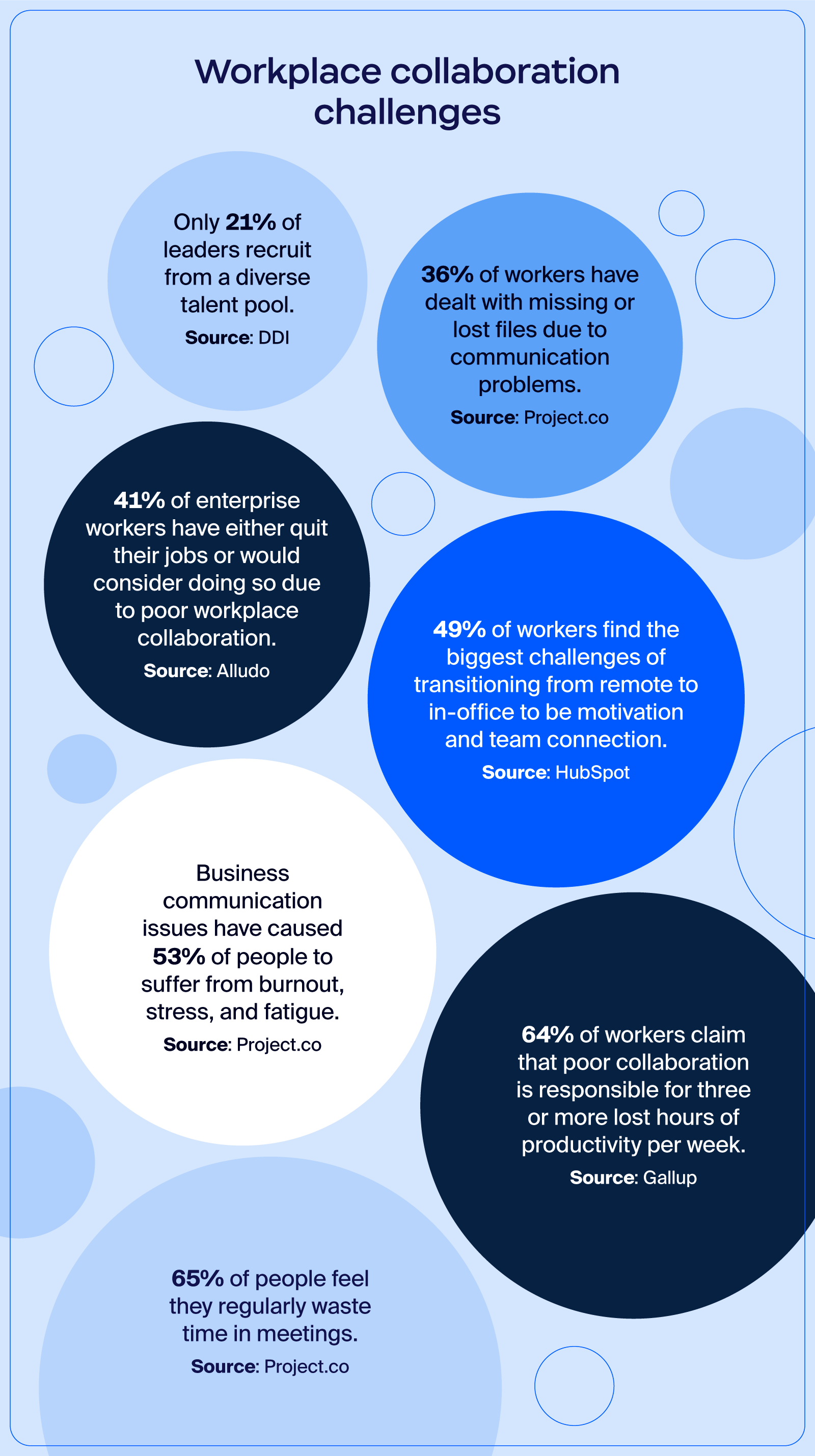
Meet Zoom AI Companion, your new AI assistant!
Boost productivity and team collaboration with Zoom AI Companion, available at no additional cost with eligible paid Zoom plans.
Updated on October 21, 2025
Published on October 21, 2025


Have you ever felt like a project at work was more akin to scaling Mount Everest solo than training with friends for a collaborative climb? Deadlines loom, information seems scattered across the team, and frustration hangs heavy in the air. Unfortunately, this scenario isn’t uncommon. 63% of workers have wasted time at work due to communication problems and poor collaboration (Project.co).
On the flip side, a team that leverages everyone’s strengths is equipped to seamlessly tackle complex challenges. Aligned teams communicate better, move faster, and solve complex problems more effectively. Below, we explore some recent collaboration trends, teamwork practices, and workplace collaboration statistics that highlight the power of aligned teams.
In recent years, the rise of flexible and remote work has transformed traditional office environments, with many remote teams collaborating seamlessly across geographical distances and teams are increasingly relying on digital tools and asynchronous communication to stay aligned and productive.
But how has this large-scale adoption of remote work impacted businesses? The latest remote teamwork statistics and workplace collaboration trends tell a compelling story. While some teams struggle with an overloaded tech stack and communication gaps, some have a better work-life balance and higher efficiency.
Let’s take a look at some key teamwork statistics that highlight the opportunities and challenges of remote collaboration:
1. 71% of leaders see a positive impact on employee happiness and satisfaction due to hybrid and remote work options. (Morning Consult Survey commissioned by Zoom)
2. 36% of employees feel remote work has a negative impact on workplace collaboration. (FlexJobs)
3. 28% of workers feel they have a higher workload working remotely compared to when they were going into the office. (FlexJobs)
4. Out of hybrid, in-office, and remote employees, remote employees were the most positive about collaboration and communication. 72% of surveyed remote workers said they have open and honest two-way communication (compared to 67% of in-office and 64% of hybrid workers). (Culture Amp)

It’s no secret that the modern workplace relies on employee collaboration, whether it’s remote, hybrid, or in-office work. In fact, collaboration in the workplace has become a cornerstone of modern business strategy. But how do employees feel about it, and what does collaboration look like? These workplace collaboration statistics offer a clearer picture of how teams communicate in the current landscape, where collaboration is working well, and where it still needs to be improved.
Whether you’re building in-office connections or managing remote teams, these teamwork statistics reveal why collaboration remains critical in every work environment:
5. 75% of leaders whose teams use AI say their teams collaborate better. (Morning Consult Survey commissioned by Zoom)
6. Office workers spend most of their time (42% on average) collaborating with others. (Gensler)
7. 53% of people don’t find communicating in the workplace any more challenging than it was in 2024. In fact, 24% of survey responders find communication less challenging than it was the year before. (Project.co)
8. Two-thirds of executives and managers say most recent hires aren’t fully prepared due to a lack of experience, highlighting the need for close collaboration and communication. (Deloitte)
By fostering teamwork, companies can unlock a wide variety of benefits, including enhanced creativity and problem-solving thanks to diverse perspectives and combined expertise. Beyond the obvious perks, why is collaboration more important in the workplace today than ever? Collaboration is the glue that keeps teams agile and efficient, reducing silos and encouraging accountability.
Below, you’ll find some proven benefits of team collaboration:
9. 76% of people who primarily use some type of project management tool to communicate with coworkers report better efficiency. (Project.co)
10. 45% of employees said that poor communication is affecting their ability to trust their coworkers. (Forbes)
11. Businesses saw employee engagement decline to 21% in 2024, which resulted in the loss of $438 billion for the global economy. (Gallup)

While we know team collaboration is crucial, technology makes it much easier for us to stay connected, no matter where our peers are located. Whether your teams rely on video conferencing or shared workspaces and instant messaging tools, technology is a foundation of collaboration in the workplace.
In fact, companies are increasingly investing in digital solutions to keep teams aligned, productive, and connected, regardless of location.
Let’s look at some statistics that show how much we rely on technology for team collaboration and communication.
12. Employees using more than 10 apps report communication issues at a higher rate (54%) than those using fewer than five apps (34%). (Zoom)
13. Leaders using AI report strong results: 85% complete tasks faster, 84% are more productive, and 81% deliver higher quality work. (Zoom)
14. 93% of workers say it’s important for them to have a good understanding of their next deliverable, deadline, and status. (Project.co)
15. As of 2024, the market for global collaboration software has been valued at $18.2 billion, signifying the reliance and importance of collaboration tools in the workplace. (Global Market Insights)
16. Only 14% of employees feel like they’re aligned with the goals of their organization, highlighting a gap for more unified communication and collaboration to help prioritize tasks. (Axios HQ)
17. Email is still the most popular way for professionals to communicate, with 36% of respondents using email to communicate with coworkers. (Project.co)
18. 26% of employees use an online chat tool to communicate with their colleagues. (Project.co)
19. Only 6% of professionals communicate via phone or face-to-face. (Project.co)

Strong teamwork is crucial for success, but several obstacles can stand in its way. From communication breakdowns to unclear roles and responsibilities, these challenges can disrupt productivity and morale.
Below are some key collaboration facts that highlight the most common obstacles professional teams face:
20. 82% of leaders and 72% of employees report that a lack of time between meetings makes it difficult to complete important tasks. (Zoom)
21. About 64% of workers claim that poor collaboration is the reason they lose three or more hours of productivity per week. (Corel)
22. 41% of employees would like to see a change in their company culture or engagement. (Gallup)
23. Only 21% of leaders report actively recruiting and promoting from diverse talent pools. (DDI)
24. About 30% of remote workers said they feel unengaged at their job. (Buffer)
25. 25% of remote employees experienced daily loneliness from a lack of connection in the office. Only 16% of onsite employees reported loneliness. (Gallup)
26. 61% of employees said they would likely leave their job because of poor communication and a lack of collaboration. (Staffbase)
27. 43% of people have suffered from burnout, stress, and fatigue due to communication issues in their business. (Project.co)
28. About one-third (31%) of people have dealt with missing or lost files at work due to communication problems. (Project.co)
29. 61% of people feel they regularly waste time in meetings. (Project.co)
30. Companies are losing business due to poor communication skills — 68% of clients have reported switching to competitors for this reason. (Project.co)

Teamwork is essential for success in today’s workplace. Recent workplace collaboration statistics highlight the importance of fostering a collaborative environment for increased productivity, improved decision-making, and greater innovation.
But these same statistics also reveal some challenges that can hinder collaboration, such as miscommunication, lack of trust, company culture, and ineffective leadership. By addressing these issues and creating a culture that values teamwork, businesses can unlock the potential of collaboration.
Embracing the right technology and encouraging open communication are important steps to overcoming barriers to collaboration.
Contact us today to see how we can help streamline communication and build trust with your team.